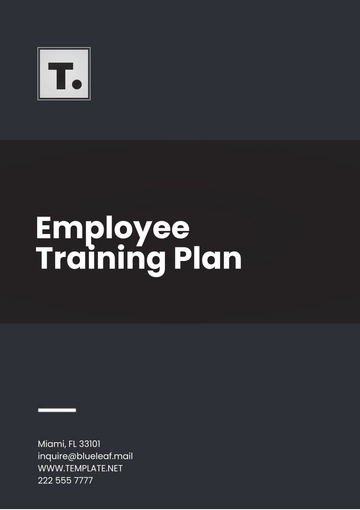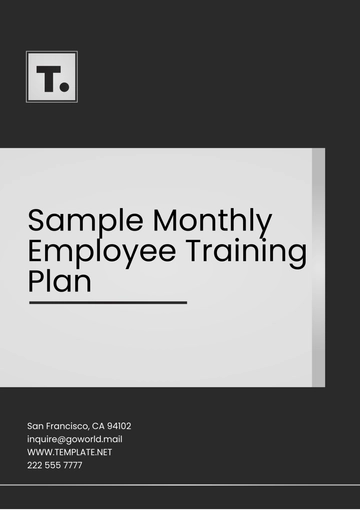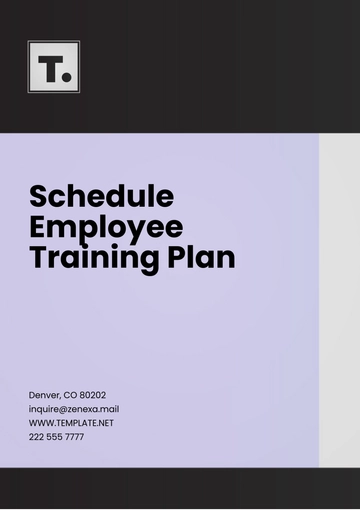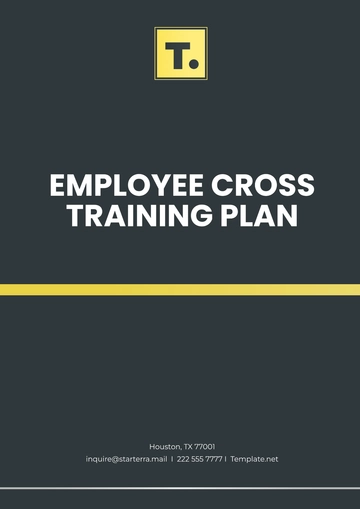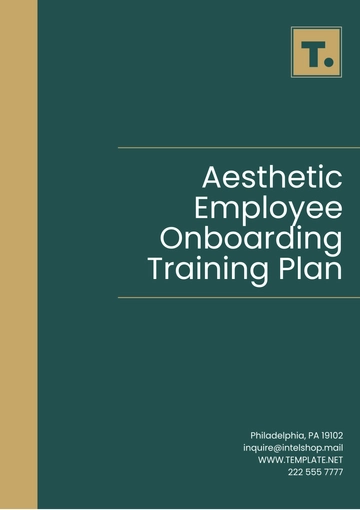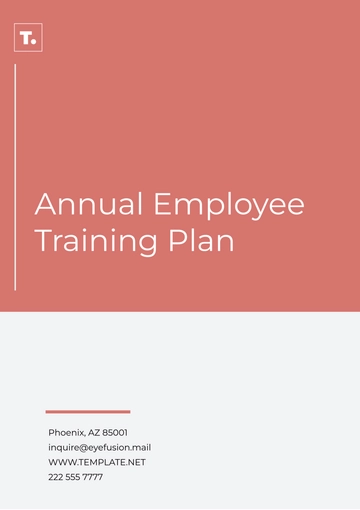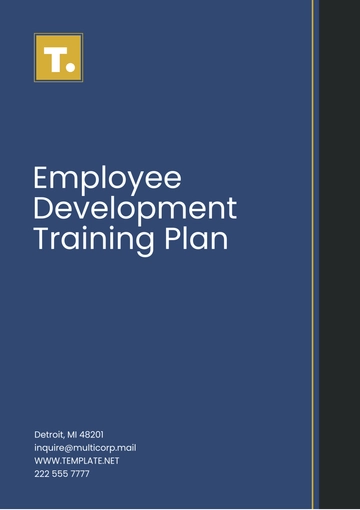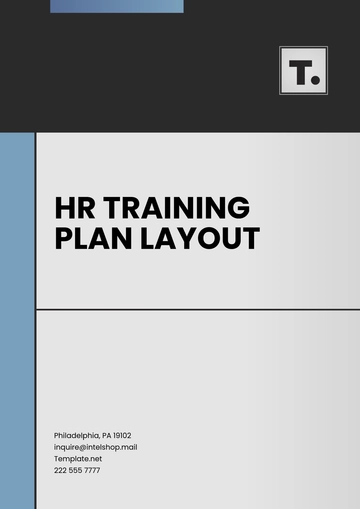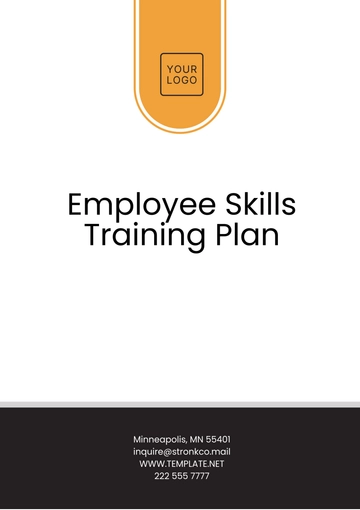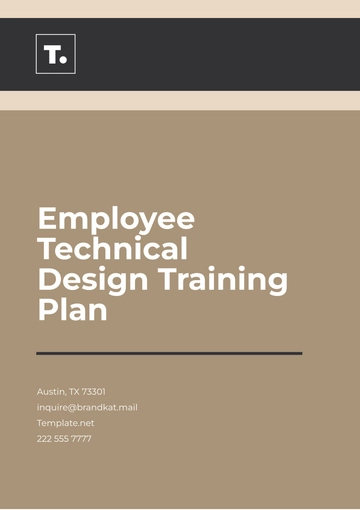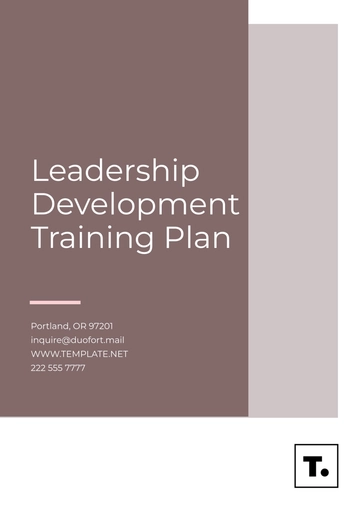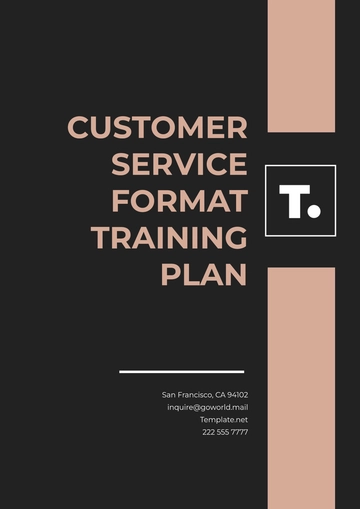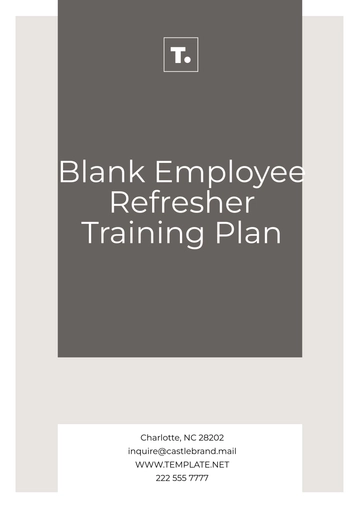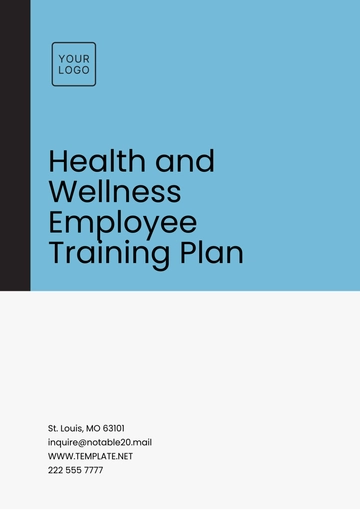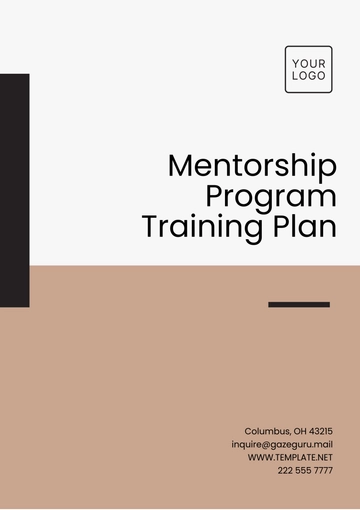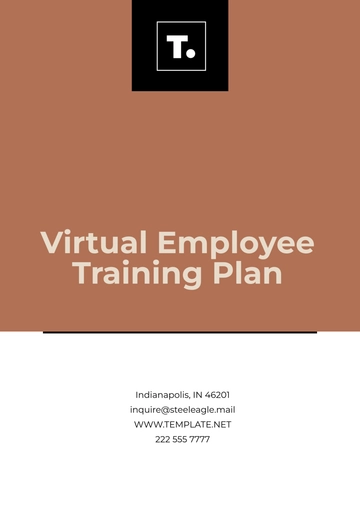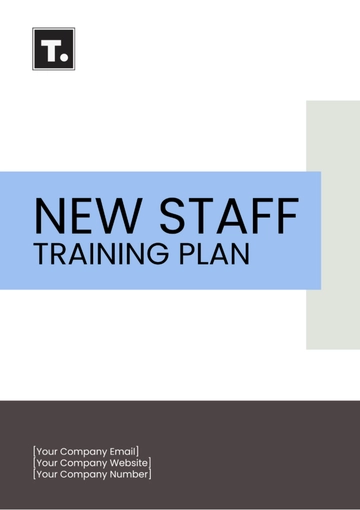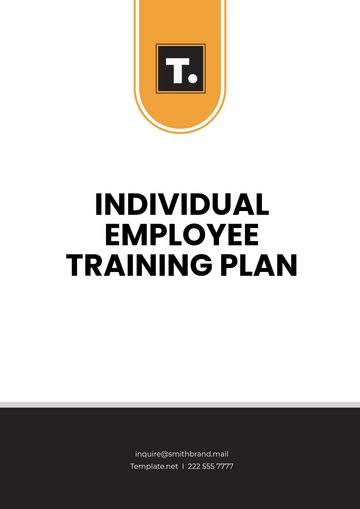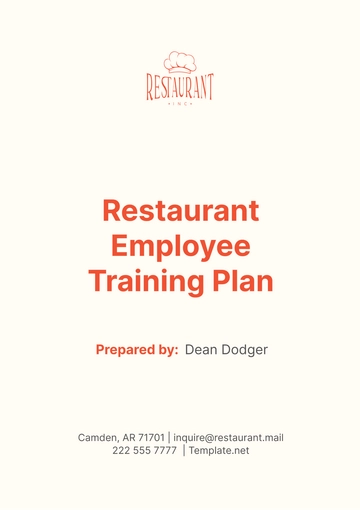Free Restaurant Employee Training Plan
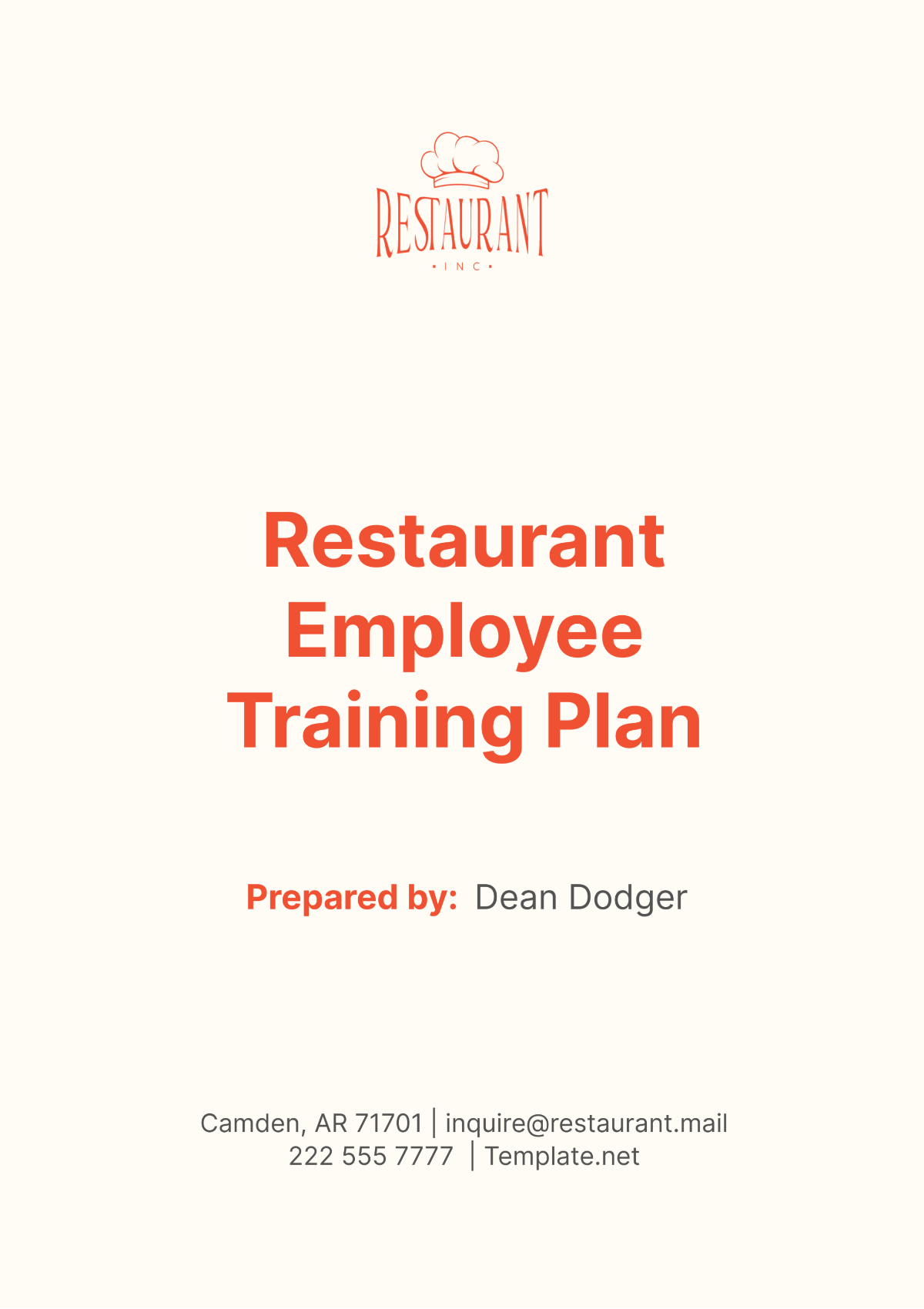
1. Introduction
A. Purpose of the Training Plan
The purpose of the employee training plan at [Your Company Name] is to ensure that all team members are equipped with the necessary skills and knowledge to perform their duties to the highest standards. This training is designed not only to boost efficiency and service quality but also to enhance employee satisfaction and retention by providing clear pathways for personal and professional development.
B. Objectives of the Training
The key objectives of our training plan include:
Enhancing customer service skills to improve guest satisfaction.
Ensuring all staff are proficient in their operational roles and responsibilities.
Promoting safety and compliance with health regulations.
Encouraging a team-oriented environment aligned with the company's values and mission.
C. Expected Outcomes for Employees and the Restaurant
By the end of the training program, employees should be able to:
Demonstrate improved proficiency in their specific roles.
Exhibit a thorough understanding of company policies and customer service expectations.
Apply health and safety protocols effectively.
Show enhanced capability in managing customer relations and operational challenges.
The restaurant will benefit from:
Higher customer satisfaction and repeat business.
Improved operational efficiency and safety.
A more motivated and cohesive team.
Reduced turnover rates and lower recruitment costs.
2. Target Audience
A. Overview of Roles to be Trained
The training program is designed for various roles within the restaurant, each requiring different skills and knowledge:
Waitstaff: Focus on customer interaction, efficiency, and accuracy.
Kitchen Staff: Emphasis on culinary skills, safety, and speed.
Management: Leadership, problem-solving, and administrative duties.
B. Specific Needs per Role
Each role has unique training needs, which are addressed through tailored modules:
Role | Specific Needs |
|---|---|
Waitstaff | Communication, POS system use, customer care |
Kitchen Staff | Food prep safety, equipment handling, recipe execution |
Management | Staff management, conflict resolution, reporting |
C. Training Group Sizes and Composition
Training will be conducted in small groups to maximize effectiveness and interaction:
Waitstaff: Groups of 10-12 for role-playing and scenario-based training.
Kitchen Staff: Groups of 5-7 for hands-on culinary training.
Management: Groups of 3-5 for leadership workshops and strategy sessions.
3. Training Modules
The training modules are specifically designed to cater to the distinct needs of each role within the restaurant.
Module | Target Group | Content Overview | Key Skills |
|---|---|---|---|
Company Culture and Expectations | All Employees | Introduction to the restaurant's history, mission, and values; dress code; conduct standards | Understanding of company ethos, professional behavior |
Role-Specific Skills | Separated by role: Waitstaff, Kitchen Staff, Management | Waitstaff: Order taking, customer interaction, POS handling; Kitchen Staff: Food prep safety, equipment usage; Management: Operational oversight, staff coordination | Job-specific operational efficiency and expertise |
Health and Safety | All Employees | Food safety, personal hygiene, emergency response procedures, COVID-19 protocols | Compliance with health standards, safety in the workplace |
Customer Service Excellence | Front of House Staff (Waitstaff, Hosts) | Building rapport, handling complaints, upselling techniques | Enhanced customer interaction, problem-solving |
Advanced Training | Specialized Roles: Chefs, Bartenders, Managers | Chefs: Advanced culinary techniques; Bartenders: Beverage knowledge and mixology; Managers: Advanced leadership and strategic planning | Specialized skills in culinary arts, beverage service, and leadership |
4. Training Methods
For [Your Company Name], a variety of training methods are strategically employed to cater to different learning styles, operational needs, and job functions.
A. Overview of Training Methods
Training Method | Objective | Content Delivered | Ideal For |
|---|---|---|---|
In-Person Training Sessions | Deliver foundational knowledge and company policies | Theoretical knowledge, company policies, compliance requirements | All employees, especially new hires |
On-the-Job Training | Apply learned skills in real-world settings | Practical skills application, operational tasks | Waitstaff, kitchen staff |
Online Courses and Webinars | Provide flexible learning options and access to specialists | Specialized topics, flexible learning, expert sessions | Management, advanced training sessions |
Role-Playing and Simulations | Simulate real-life scenarios for practice | Customer service scenarios, emergency response | Front of house staff, management |
Interactive Workshops | Foster creativity and hands-on experience | Culinary arts, beverage preparation, customer engagement | Chefs, bartenders, waitstaff |
Mentorship Programs | Offer ongoing support and development | Role-specific skills, peer learning, leadership development | New employees, employees in new roles |
E-Learning Platforms | Standardize training and maximize accessibility | Foundational knowledge, compliance training | Suitable for all roles at multiple locations |
Feedback-Driven Learning | Adapt training based on participant feedback | Training adjustments, continuous improvement | All employees, continuous training |
B. Training Method Descriptions
Method | Description |
|---|---|
In-Person Training Sessions | Traditional classroom settings facilitate direct interaction between trainers and trainees, ideal for introducing new employees to company standards and expectations. |
On-the-Job Training | Hands-on training under the supervision of experienced staff, is crucial for practical understanding and skill mastery in high-pressure environments like kitchens and busy dining areas. |
Online Courses and Webinars | Utilized for delivering training by experts from around the world, allowing staff to learn at their own pace and revisit content as needed. |
Role-Playing and Simulations | Employees practice and react to simulated scenarios which improve their handling of real-life situations, such as dealing with difficult customers or managing a dining rush. |
Interactive Workshops | Workshops encourage active participation in learning new recipes, bartending skills, or engaging customer service techniques through practical, hands-on sessions. |
Mentorship Programs | Experienced employees guide newer or less experienced staff, enhancing skills transfer and reinforcing a supportive work culture. |
E-Learning Platforms | Provides a consistent training experience across multiple locations, ensuring all employees, regardless of location, receive the same training. |
Feedback-Driven Learning | Training programs are continuously improved based on feedback collected from participants, ensuring that the training remains relevant and effective. |
This comprehensive approach to training utilizes a blend of traditional and modern methods to ensure that all staff at [Your Company Name] are well-equipped to meet and exceed operational and service expectations.
5. Schedule and Timeline
The training schedule is structured to ensure comprehensive coverage without overwhelming the staff. It will be implemented in phases according to the availability of staff and the operational demand of the restaurant.
Module | Duration | Start Date | End Date | Time |
|---|---|---|---|---|
Company Culture | 2 days | [Date] | [Date] | [Time] |
Role-Specific Skills | 1 week | [Date] | [Date] | [Time] |
Health and Safety | 3 days | [Date] | [Date] | [Time] |
Customer Service | 4 days | [Date] | [Date] | [Time] |
Advanced Training | 5 days | [Date] | [Date] | [Time] |
Breakdown for Part-Time and Full-Time Employees:
Full-Time Employees: Scheduled during regular working hours.
Part-Time Employees: Scheduled for evenings and weekends to accommodate their availability.
6. Assessment and Certification
A. Purpose of Assessment
At [Your Company Name], the purpose of assessments is to ensure that each employee has achieved a sufficient understanding of the training material and can competently apply these skills in their daily responsibilities. This approach not only improves individual performance but also ensures that our team collectively meets our high standards of service and safety.
B. Assessment Methods
To comprehensively evaluate the progress and proficiency of employees, we employ several assessment methods:
Method | Description | Used For |
|---|---|---|
Practical Exams | Hands-on tests to demonstrate skill proficiency in real-life scenarios, such as food preparation or customer interaction. | Kitchen staff, waitstaff |
Written Tests | Tests to assess understanding of theoretical knowledge, company policies, and procedural compliance. | All employees |
Performance Reviews | Regular evaluations by supervisors based on predefined criteria to monitor ongoing performance. | All employees |
Peer Reviews | Feedback from colleagues on team interaction, cooperation, and skill application. | All employees, especially in team settings |
C. Certification Criteria
Certificates are issued based on the successful completion of assessments, signifying an employee's capability and readiness. The criteria include:
Passing practical exams with at least a 75% score.
Achieving at least 80% in written tests.
Positive feedback from performance and peer reviews.
D. Documentation and Tracking
All the results of assessments and certifications are rigorously documented and systematically monitored through our Human Resources management system. This thorough documentation facilitates the process of determining the effectiveness of the training programs and also aids in pinpointing potential areas that require additional development.
7. Resources Required
A. Human Resources
Key personnel involved in the training program include:
Role | Responsibilities |
|---|---|
Training Coordinator | Overseeing the training schedule, ensuring all resources are available and sessions are conducted as planned. |
Trainers | Subject matter experts who deliver training sessions and assess participant performance. |
HR Managers | Managing documentation, feedback, and compliance with training standards. |
B. Material Resources
Essential materials needed for the training include:
Resource | Purpose |
|---|---|
Training Manuals | Comprehensive guides for both trainers and trainees on course content and expectations. |
Educational Tools | Includes AV equipment for presentations, cooking utensils for culinary training, and POS systems for sales training. |
Online Access Codes | For e-learning modules and virtual training sessions. |
C. Financial Resources
A preliminary budget is set to cover:
Trainer fees and salaries.
Purchase and maintenance of training materials and equipment.
Costs associated with certification and documentation.
8. Feedback and Evaluation
A. Feedback Mechanisms
To ensure continuous improvement, feedback is collected through various channels:
Method | Purpose |
|---|---|
Post-Training Surveys | To gauge immediate reactions and learning outcomes from trainees shortly after sessions conclude. |
Follow-Up Interviews | Conducted with participants and managers to discuss the long-term impact and applicability of training. |
Suggestion Boxes | Placed in common areas to collect ongoing feedback and suggestions for training improvement. |
B. Scheduled Reviews
The training program is subjected to systematic reviews which are organized on a quarterly basis. During these reviews, various aspects are carefully examined which include the analysis of feedback received from participants, the assessment of the effectiveness of the current training modules, and the implementation of any necessary modifications to enhance the training program. Key stakeholders, such as department heads and representatives from the human resources department, actively participate in these review sessions.
C. Adjustments Based on Feedback
The training program undergoes modifications based on the feedback that has been gathered, in order to rectify any deficiencies or to incorporate the latest practices and technologies from the industry. This process ensures that the training remains both relevant and effective in achieving its goals..
9. Follow-up and Continuous Learning
A. Ongoing Training Opportunities
To foster continuous learning and skill enhancement, [Your Company Name] offers:
Monthly workshops on varying topics such as new menu items, customer service trends, and compliance updates.
Annual refresher courses for all employees to update their skills and knowledge base.
B. Scheduled Refresher Courses
Refresher courses are scheduled as follows:
Course | Frequency | Purpose |
|---|---|---|
Safety and Compliance | Annually | To update staff on safety protocols and compliance changes. |
Customer Service | Bi-annually | To refresh and introduce new techniques in customer interaction. |
C. Advanced Training Options
For employees seeking career advancement or specialized skills, we provide:
Leadership development programs for potential management candidates.
Advanced culinary arts training for chefs.
10. Conclusion
A. Recap of Training Plan Importance
The comprehensive training plan at [Your Company Name] is designed to equip our staff with the necessary skills and knowledge to excel in their roles, ensuring our restaurant operates at the highest standard. This structured approach benefits both employee development and overall business performance.
B. Final Remarks
We are committed to continuous improvement and adaptation of our training program to meet the evolving needs of our industry and workforce. By investing in our employees' growth, we are building a stronger, more competitive, and customer-focused restaurant. This detailed approach to training and development reflects [Your Company Name]'s commitment to excellence and ensures our staff not only meets but exceeds the expectations of our valued customers.
- 100% Customizable, free editor
- Access 1 Million+ Templates, photo’s & graphics
- Download or share as a template
- Click and replace photos, graphics, text, backgrounds
- Resize, crop, AI write & more
- Access advanced editor
Develop your team effectively with Template.net's Restaurant Employee Training Plan Template. Fully customizable and editable through our AI Editor Tool, this template provides a structured approach to employee development, allowing you to schedule and execute training that enhances skills and improves service quality. Vital for maintaining high standards and employee satisfaction.
You may also like
- Finance Plan
- Construction Plan
- Sales Plan
- Development Plan
- Career Plan
- Budget Plan
- HR Plan
- Education Plan
- Transition Plan
- Work Plan
- Training Plan
- Communication Plan
- Operation Plan
- Health And Safety Plan
- Strategy Plan
- Professional Development Plan
- Advertising Plan
- Risk Management Plan
- Restaurant Plan
- School Plan
- Nursing Home Patient Care Plan
- Nursing Care Plan
- Plan Event
- Startup Plan
- Social Media Plan
- Staffing Plan
- Annual Plan
- Content Plan
- Payment Plan
- Implementation Plan
- Hotel Plan
- Workout Plan
- Accounting Plan
- Campaign Plan
- Essay Plan
- 30 60 90 Day Plan
- Research Plan
- Recruitment Plan
- 90 Day Plan
- Quarterly Plan
- Emergency Plan
- 5 Year Plan
- Gym Plan
- Personal Plan
- IT and Software Plan
- Treatment Plan
- Real Estate Plan
- Law Firm Plan
- Healthcare Plan
- Improvement Plan
- Media Plan
- 5 Year Business Plan
- Learning Plan
- Marketing Campaign Plan
- Travel Agency Plan
- Cleaning Services Plan
- Interior Design Plan
- Performance Plan
- PR Plan
- Birth Plan
- Life Plan
- SEO Plan
- Disaster Recovery Plan
- Continuity Plan
- Launch Plan
- Legal Plan
- Behavior Plan
- Performance Improvement Plan
- Salon Plan
- Security Plan
- Security Management Plan
- Employee Development Plan
- Quality Plan
- Service Improvement Plan
- Growth Plan
- Incident Response Plan
- Basketball Plan
- Emergency Action Plan
- Product Launch Plan
- Spa Plan
- Employee Training Plan
- Data Analysis Plan
- Employee Action Plan
- Territory Plan
- Audit Plan
- Classroom Plan
- Activity Plan
- Parenting Plan
- Care Plan
- Project Execution Plan
- Exercise Plan
- Internship Plan
- Software Development Plan
- Continuous Improvement Plan
- Leave Plan
- 90 Day Sales Plan
- Advertising Agency Plan
- Employee Transition Plan
- Smart Action Plan
- Workplace Safety Plan
- Behavior Change Plan
- Contingency Plan
- Continuity of Operations Plan
- Health Plan
- Quality Control Plan
- Self Plan
- Sports Development Plan
- Change Management Plan
- Ecommerce Plan
- Personal Financial Plan
- Process Improvement Plan
- 30-60-90 Day Sales Plan
- Crisis Management Plan
- Engagement Plan
- Execution Plan
- Pandemic Plan
- Quality Assurance Plan
- Service Continuity Plan
- Agile Project Plan
- Fundraising Plan
- Job Transition Plan
- Asset Maintenance Plan
- Maintenance Plan
- Software Test Plan
- Staff Training and Development Plan
- 3 Year Plan
- Brand Activation Plan
- Release Plan
- Resource Plan
- Risk Mitigation Plan
- Teacher Plan
- 30 60 90 Day Plan for New Manager
- Food Safety Plan
- Food Truck Plan
- Hiring Plan
- Quality Management Plan
- Wellness Plan
- Behavior Intervention Plan
- Bonus Plan
- Investment Plan
- Maternity Leave Plan
- Pandemic Response Plan
- Succession Planning
- Coaching Plan
- Configuration Management Plan
- Remote Work Plan
- Self Care Plan
- Teaching Plan
- 100-Day Plan
- HACCP Plan
- Student Plan
- Sustainability Plan
- 30 60 90 Day Plan for Interview
- Access Plan
- Site Specific Safety Plan
